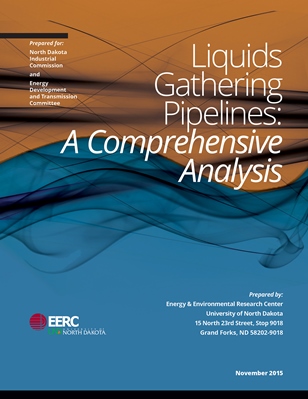About the Study
The last decade has seen growth in the oil industry at a rate that is unprecedented in the history of North Dakota. There are over 12,000 oil wells in the state, with oil production undergoing a nearly fivefold increase since 2008. Saltwater (“produced water”) is also produced along with the oil in volumes comparable to oil production. Industry has installed nearly 23,000 miles of gathering pipeline to move these tremendous volumes of fluids from the wellhead to various processing facilities. While the vast majority of the fluids moving through the state’s pipeline infrastructure reach their destination without incident, the ever-increasing size of the system means that even low incident rates may result in a greater number of spills and attendant volumes in a given year. With that in mind, public concern has been growing in North Dakota about the effects of spills of oil and produced water on agriculture, public health, and the environment.
To address those concerns, the North Dakota legislature passed two bills in two separate legislative sessions -- North Dakota House Bill 1358 (2015) and North Dakota House Bill 1347 (2017). The purpose of this legislation was to address public concern over what was perceived as a growing problem with oil and produced water spills in the state as a result of increased exploration and production activity in the oil industry. The Legislative directives directed state funding for research efforts intended to minimize the number of spills and the volume of fluids spilled.
Phase I - Foundations
One of the key elements of HB1358 was a mandate for the EERC to conduct a study of the oil and produced water gathering pipeline network in North Dakota. Specifically, Section 8 of HB1358 directed the EERC to analyze the existing regulations on construction and monitoring of crude oil and produced water pipelines, determine the feasibility and cost-effectiveness of requiring leak detection and monitoring technology on new and existing pipeline systems, and provide a report with recommendations to the state by December 1, 2015. The intent of this study was to assess ways to improve the performance of produced water and crude oil pipelines in North Dakota, with the purpose of supporting NDIC’s decisions regarding possible adoption of administrative rules impacting pipeline safety and integrity.
Click here to read the full study(Phase I).
Phase II - Field Evaluations of Leak Detection Approaches
HB1358 further directed the EERC to conduct a field evaluation of leak detection and monitoring systems under real-world conditions. The results of this field evaluation provided valuable understanding and data about leak detection systems performance on gathering pipelines, and supported efforts to allow monetization of North Dakota’s vast petroleum resources while protecting public safety and the environment.
Click here to read the field evaluation report (Phase II).
Phase III - Phase III – Emerging Technology and Risk Assessment
HB1347 directed the EERC to continue the study of liquids gathering pipelines, focusing on emerging leak detection technologies and their application to liquids gathering pipelines, and approaches to risk assessment and their application to liquids gathering pipelines.
Click here to read the report on emerging technologies and risk assessment (Phase III).
For more information on the pipeline study, please contact Josh Stanislowski, Director of Energy Systems Development, at 701-777-5087 or jstanislowski@undeerc.org, or Austin McRae, Research Engineer, Integrated Petroleum Systems, at 701-777-5402 or amcrae@undeerc.org.


